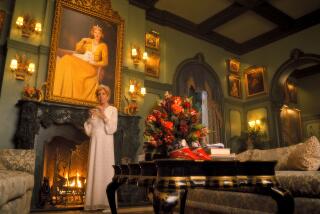How ‘Mandalorian’ re-created its ‘Star Wars’ origins — down to the cantina
To reimagine the world of “Star Wars” for Jon Favreau’s Disney+ series “The Mandalorian,” production designer Andrew L. Jones had to build sets that could exist both in the physical world and a virtual one. The series was partially filmed in Industrial Light & Magic’s new 270-degree “Volume” soundstage, where digital environments — a desert planet, say, or the infamous cantina — are projected on LED screens around the actors using game technology.
“I’d done some work with LED screens in camera before, but not with the tracking element, on ‘The Jungle Book,’” says Jones, who was supervising art director on Favreau’s live-action Disney film. “Jon had started a lot of the early thinking for this process on that. We were using LED panels for lighting. We were building the sets and scanning them in VR. And then Jon took that further on ‘The Lion King.’ It was an evolution, and by the time we got to ‘The Mandalorian’ everything had matured enough that we felt we could make it work.”
The technology meant that Jones, who was nominated for an Emmy alongside art director Jeff Wisniewski and set decorator Amanda Serino, and his team needed to design and build all the sets six weeks before shooting each episode to give ILM enough time to make the virtual sets look photo-real and to add in real-time special effects.
To do that, the team filmed tangible environments, including locations in Iceland, and created realistic scans of shapes, props and scenery. In the first episode, the Client’s office was scanned from the interior of a warehouse in downtown Los Angeles. Those digital backgrounds appeared on the screens of the Volume, a circular, 270-degree LED video wall housed at Manhattan Beach Studios; when it was time to shoot, Jones and Serino augmented each set with physical objects and props, including sand and dirt for the ground.
“That’s a really good way to sell the illusion, to have something that’s real in the foreground and then a duplicate of it in the virtual,” Jones notes. “If they’re lit and presented consistently, then it’s hard to tell what’s real and what isn’t.”
The much-anticipated series “The Mandalorian,” launching Nov. 12 on Disney+, will feature plenty that’s fresh to “Star Wars” fans.
The set pieces also needed to be mobile, able to move in and out of the Volume quickly to keep up with the shooting schedule.
“The Volume is not a huge space, and anything we want to shoot on there we’ve got to get it in and out easily,” says Jones, who also built sets on several soundstages and on the studio’s backlot. “For the sake of the schedule we can’t build a set like you would do traditionally and spend three weeks putting it together and dressing it and painting it. We’ve got to literally get that thing in overnight and do some lighting in the morning and then we’re shooting. It’s much more like theater, where all the set pieces have to be on wheels. They have to break apart into pieces we can get through the door. As soon as one’s out, the next one’s coming in.”
Despite having access to the latest digital technology, Jones wanted to ensure that the aesthetic of “The Mandalorian” wasn’t too perfect or too manufactured. It needed to match the look of the first “Star Wars” trilogy, especially “A New Hope,” and Favreau was clear that the visual effects shouldn’t overtake the storytelling.
“When you’ve got ILM on board, we can do anything,” Jones says. “You can have the most spectacular skies and spaceships and visual effects. But then it would start not to be the world of ‘Star Wars’ and the language of ‘Star Wars.’ Those original films were really ground-breaking stuff, but it had a simplicity to it. We are definitely trying to respect the original aesthetic.”
There are visual nods to the original trilogy throughout “The Mandalorian,” and re-creating the cantina was a particular challenge. Originally, the team wasn’t sure such a small set would work on the Volume, but in the end they were able to make an aged replica of the space that was half virtual and half built set.
“We wanted to be absolutely faithful to that set,” Jones says. “That was a bit of archaeology, finding what was there and how it was positioned and what would have happened in the intervening years that would have changed it. It’s not the exact same thing — it’s the same place but it’s later on. There’s going to be some storytelling in how things have changed since the fall of the Empire. Things have gone to seed a little bit.”
Baby Yoda has shared the screen with plenty of characters during the first season of “The Mandalorian” on Disney+. We ranked them.
When it came time to shoot the second season, which is set to premiere later this year, the team was able to bring in what they’d learned the first time around.
“We found things that were successful that we hadn’t expected and other things failed that we thought were going to be easy,” Jones says. “We learned a lot as we were going along. I think we’re starting to understand this process and get the hang of it. So Season 2 was just as difficult of a season, but I think we achieved greater things.”
More to Read
The complete guide to home viewing
Get Screen Gab for everything about the TV shows and streaming movies everyone’s talking about.
You may occasionally receive promotional content from the Los Angeles Times.






